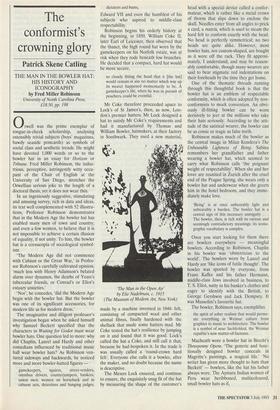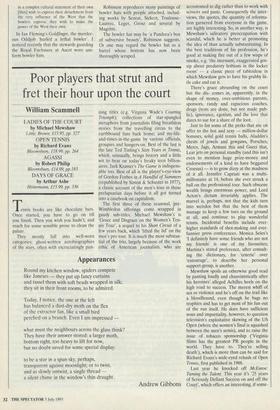The conformist's crowning glory
Patrick Skene Catling
THE MAN IN THE BOWLER HAT: HIS HISTORY AND ICONOGRAPHY by Fred Miller Robinson University of North Carolina Press, £18.50, pp. 198 Orwell was the prime exemplar of tongue-in-cheek scholarship, analysing ostensibly trivial subjects (boys' magazines, bawdy seaside postcards) as symbols of social class and aesthetic trends. He might have devoted 1,000 words or so to the bowler hat in an essay for Horizon or Tribune. Fred Miller Robinson, the indus- trious, perceptive, astringently witty occu- pant of the Chair of English at the University of San Diego, stretches the Orwellian serious joke to the length of a doctoral thesis, yet it does not wear thin.
In an ingeniously suggestive, stimulating and amusing survey, rich in data and ideas, its text well complemented with 52 illustra- tions, Professor Robinson demonstrates that in the Modern Age the bowler hat has enabled many men of town and country, and even a few women, to believe that it is not impossible to achieve a certain illusion of equality, if not unity. To him, the bowler hat is a cornucopia of sociological symbol- ism.
'The Modern Age did not commence with Cubism or the Great War,' in Profes- sor Robinson's carefully cultivated opinion, 'much less with Henry Adamson's belated alarm over dynamos, the deaths of Yeats's tubercular friends, or Conrad's or Eliot's estuary anxieties.'
'Nor', he concedes, 'did the Modern Age begin with the bowler hat. But the bowler was one of its significant accessories, for modern life as for modern dress.'
The imaginative and diligent professor's investigation began when he asked himself why Samuel Beckett specified that the characters in Waiting for Godot must wear bowler hats. One question led to more: why did Chaplin, Laurel and Hardy and other comedians influenced by traditional music hall wear bowler hats? As Robinson ven- tured sideways and backwards, he noticed more and more bowler-hatted figures —
gamekeepers, squires, street-vendors, omnibus drivers, counterjumpers, bankers, union men, women on horseback and in cabaret acts, detectives and hanging judges, dictators and bums,
Edward VII and even the humblest of his subjects who aspired to middle-class respectability.
Robinson begins his orderly history at the beginning, in 1850. William Coke II, later Earl of Leicester, then observed that the thanet, the high round hat worn by the gamekeepers on his Norfolk estate, was at risk when they rode beneath low branches. He decided that a compact, hard hat would be more secure,
so closely fitting the head that it [the hat] would remain in situ no matter which way up its wearer happened momentarily to be. A gamekeeper's life, when he was in pursuit of poachers, could be eventful.
Mr Coke therefore proceeded apace to Lock's of St James's, then, as now, Lon- don's premier hatters. Mr Lock designed a hat to satisfy Mr Coke's requirements and had it manufactured by Thomas and William Bowler, hatmakers, at their factory in Southwark. They used a new material, 'The Man in the Open Air' by Elie Nadelman, c. 1915 (The Museum of Modem Art, New York) made by a machine invented in 1846: felt, consisting of compacted wool and other animal fibres, finally hardened with the shellack that made some hatters mad. Mr Coke tested the hat's resilience by jumping on it and found that it was good. Lock's called the hat a Coke, and still call it that, because he had bespoken it. In the trade it was usually called a 'round-crown hard felt'. Everyone else calls it a bowler, after the maker, and no doubt because the name is descriptive.
The Messrs Lock ensured, and continue to ensure, the exquisitely snug fit of the hat by measuring the shape of the customer's head with a special device called a confor- mateur, which is rather like a metal crown of thorns that slips down to enclose the skull. Needles enter from all angles to prick a card, a matrix, which is used to steam the hard felt to conform exactly with the head. No head is perfectly symmetrical; no two heads are quite alike. However, most bowler hats, not custom-shaped, are bought as it were off the rack. They fit approxi- mately, I understand, and may be reason- ably comfortable, though many wearers are said to bear stigmatic red indentations on their foreheads by the time they get home.
One of the thematic threads running through this thoughtful book is that the bowler hat is an emblem of respectable conformity, which is often adopted by non- conformists to mock convention. An obvi- ously ill-fitting bowler can be worn derisively to jeer at the millions who take their hats seriously. According to the atti- tude of the satirical wearer, the bowler can be as comic or tragic as false teeth.
Robinson makes much of the bowler as the central image in Milan Kundera's The Unbearable Lightness of Being. Sabina remembers her grandfather and father wearing a bowler hat, which seemed to carry what Robinson calls 'the poignant weight of respectability'. When she and her lover are reunited in Zurich after the cruel end of the Prague Spring, she wears only a bowler hat and underwear when she greets him in the hotel bedroom, and they imme- diately make love.
'Being' is at once unbearably light and unbearably a burden. The bowler hat is a central sign of this necessary ambiguity . . . The bowler, then, is rich with its various and seemingly contradictory meanings; its icono- graphic vocabulary is complex.
Once you start looking for them there are bowlers everywhere — meaningful bowlers. According to Robinson, Chaplin in his bowler was 'obstetrician to the world'. The bowlers worn by Laurel and Hardy are 'like icons of futile thought'. The bowler was sported by everyone, from Franz Kafka and his father Hermann, middle-class Jews involved in business, to T. S. Eliot, natty in his banker's clothes and eager to identify with the British, to George Gershwin and Jack Dempsey. It was Mussolini's favourite hat.
The bowler, Robinson says, exemplifies
the spirit of sober realism that would perme- ate everything in Weimar culture from graphics to music to architecture. The bowler is a symbol of neue Sachlichiceit, the Weimar republic's new matter-of-factness.
Macheath wore a bowler hat in Brecht's Threepenny Opera. 'The generic and func- tionally designed bowler conceals in Magritte's paintings, a magical life.' No writer has given more thought to hats than Beckett' — bowlers, like the hat his father always wore. The Aymara Indian women of Peru wear beribboned, multicoloured, small bowler hats as if,
in a complex cultural statement of their own [they] wish to express their detachment from the very influence of the West that the bowlers express; they wish to make the power of the West their own.
In tan Fleming's Goldfinger, the murder- ous Oddjob 'hurled a lethal bowler'. I noticed recently that the stewards guarding the Royal Fnclosure at Ascot wore uni- form bowler hats.
Robinson reproduces many paintings of bowler hats with people attached, includ- ing works by Seurat, Sickert, Toulouse- Lautrec, Leger, Grosz and several by Magritte.
The bowler hat may be 'a Pandora's box of subversive beauty', Robinson suggests. Or one may regard the bowler hat as a barrel whose bottom has now been thoroughly scraped.



















































 Previous page
Previous page